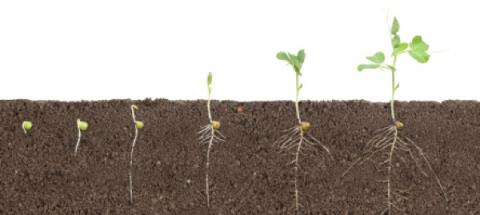
“Plant peas in February” is the rule I've heard living in Southern Oregon. Last year that didn't work at all, as our wet spring rotted out every planted pea until things began to dry out in May. After a slow start the peas burst out of the ground, and quickly flowered, fruited, and wilted, leaving only a few weeks' worth of edible peas to enjoy.
So far 2012 is shaping up differently. We've had a dry winter by recent standards. Despite lots of frosty days, we have not seen much in the way of rain or snow. February would have been a great month to plant peas, had I not been so swamped with getting the website up and running, a project worthy of deferring peas, but not for too long.
March has come in like a manic-depressive lion, alternating between stormy and sunny days, so it seems perfect for planting peas. What about a few other seeds as well? I want lettuce started so I can eat garden salad all summer long. And beets. Not many people know it, but the difference between home grown and store bought beets rivals the celebrated difference between tomatoes from garden vs. store. Beets fresh out of the ground, not too big, barely need peeling and the leaves go right into a salad.
When to plant what? Speaking as someone without a greenhouse, planting dates have to be planned. Those of you with green houses and hoop houses can be impervious to the whims of Mother Nature, but for the rest of us, we must know the average date of the last frost.
Every packet of seeds comes with a safe date for planting, relative to the latest average frost in your area. Discovering that piece of information is most easily achieved by a visit to National Climactic Data Center's website where you can download a file for your state listing all the likely freeze dates by town. Ashland, Oregon, has last freeze dates between April 21st and May 24th. Mid-March places me 4-6 weeks before the last frost, perfect!
Into the ground went shelling and snap peas, a variety of lettuce seeds and a couple dozen beet seeds. Peas you must inoculate with a starter overnight, as it tells you on the package. The lettuce seeds are so little, you must not sneeze while handling. The beet seeds are planted in clumps, and they won't all come up. I remind myself to water the seeds on the days it doesn't rain, and to keep the scratching chickens out of the garden. When the seeds sprout, the chickens will make serious attempts to get the fresh shoots, despite the half acre they range freely in my back yard of the garden. When the seeds sprout, the chickens will make serious attempts to get the fresh shoots, despite the half acre they range freely in my back yard!
As you might gather, these are the words of a backyard gardener, not an experienced farmer. What I can speak to though is how easy it is, even for a distracted and otherwise employed person, to find the time to put out a few seeds and keep them watered. Once the sun coaxes the green to show above ground, it's easy to remember to water and then it's only a matter of weeks until harvest begins. Thinning pea and beet plants provides gourmet sprouts for salads a couple weeks before the plants themselves become edible.
Seriously, even if you have never liked beets before, plant some this year.
First Farmers' Market of the year tomorrow, will I let some garden starts tempt me?
